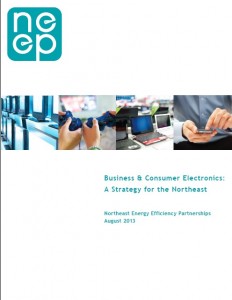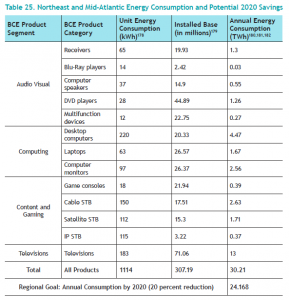By Claire Miziolek | Wed, August 21, 13
 The Northeast Mid-Atlantic region is a leader in energy efficiency and has achieved substantial energy savings over the last several decades. Innovations in lighting, HVAC, and air sealing have meant homes continue to become more efficient. But why aren’t we seeing electricity bills shrink across the board?
Well, there’s one category of home energy users, namely Business and Consumer Electronics (BCEs), that continues to grow, both in energy consumption and in the number of devices.
The total energy used by BCE products in the United States makes up 13.2% of annual residential electric energy consumption. Individually, however, BCE devices use a relatively small amount of energy, making efficiencies hard to capture. With all of these challenges, achieving energy savings for the BCE product category becomes a high hanging fruit for consumers, efficiency programs, policies, and advocacy.
The Northeast Mid-Atlantic region is a leader in energy efficiency and has achieved substantial energy savings over the last several decades. Innovations in lighting, HVAC, and air sealing have meant homes continue to become more efficient. But why aren’t we seeing electricity bills shrink across the board?
Well, there’s one category of home energy users, namely Business and Consumer Electronics (BCEs), that continues to grow, both in energy consumption and in the number of devices.
The total energy used by BCE products in the United States makes up 13.2% of annual residential electric energy consumption. Individually, however, BCE devices use a relatively small amount of energy, making efficiencies hard to capture. With all of these challenges, achieving energy savings for the BCE product category becomes a high hanging fruit for consumers, efficiency programs, policies, and advocacy.
 By now, you’re probably feeling pretty down about this problem, but cheer up! Harvesting energy savings from BCEs is now within reach. NEEP has recently released a report, Business and Consumer Electronics: A Strategy for the Northeast, to provide clear direction about how to rise up to the challenge to pick this fruit, transform the BCE market, and keep the Northeast and Mid-Atlantic region a leader in BCE efficiency.
This report, which has been added to NEEP’s BCE Resource Center, includes:
By now, you’re probably feeling pretty down about this problem, but cheer up! Harvesting energy savings from BCEs is now within reach. NEEP has recently released a report, Business and Consumer Electronics: A Strategy for the Northeast, to provide clear direction about how to rise up to the challenge to pick this fruit, transform the BCE market, and keep the Northeast and Mid-Atlantic region a leader in BCE efficiency.
This report, which has been added to NEEP’s BCE Resource Center, includes:
- An in-depth situational analysis, which takes an assessment of the entire BCE market including key market players and emerging trends
- An analysis of the energy savings and consumption of various BCE products
- A discussion of energy efficiency program designs and consumer preferences, path to purchase, and consumer attitudes
- An analysis covering the policies, labels, codes, standards, and existing policy activity in the region
- We also looked at key barriers for the advancement of BCE energy efficiency, which included product and industry, program administration, consumer, and policy.
- Finally, we discovered opportunities and developed strategies to overcome each of these barriers and pick the high hanging fruit of energy efficiency.

Through successful implementation of this strategy report, we feel that the region can achieve a goal of 20% total (TWh) BCE category energy reduction by 2020 (Insert final chart). Together as a region, we can overcome these barriers and pick the high hanging fruit of achieving energy efficiency in Business and Consumer Electronics.
Read the report! Attend to the webinar! Visit the resource center! And contact Claire for more information!